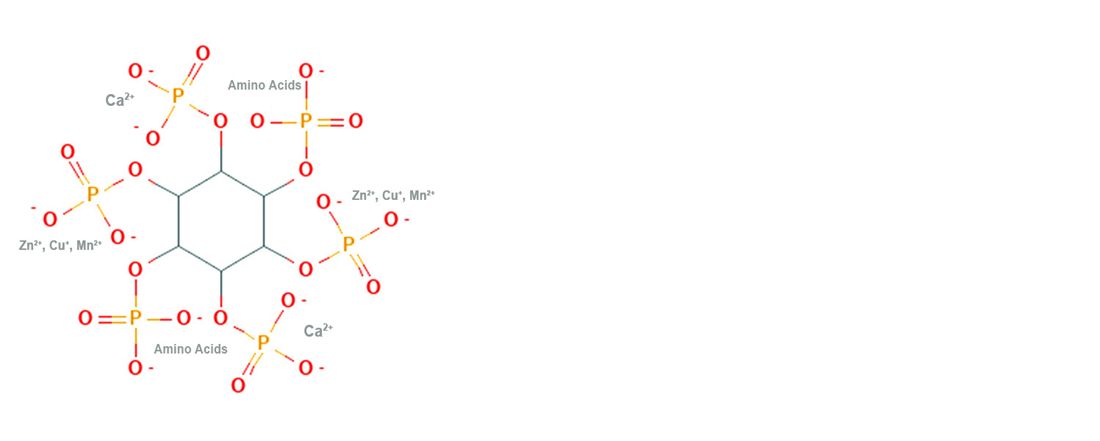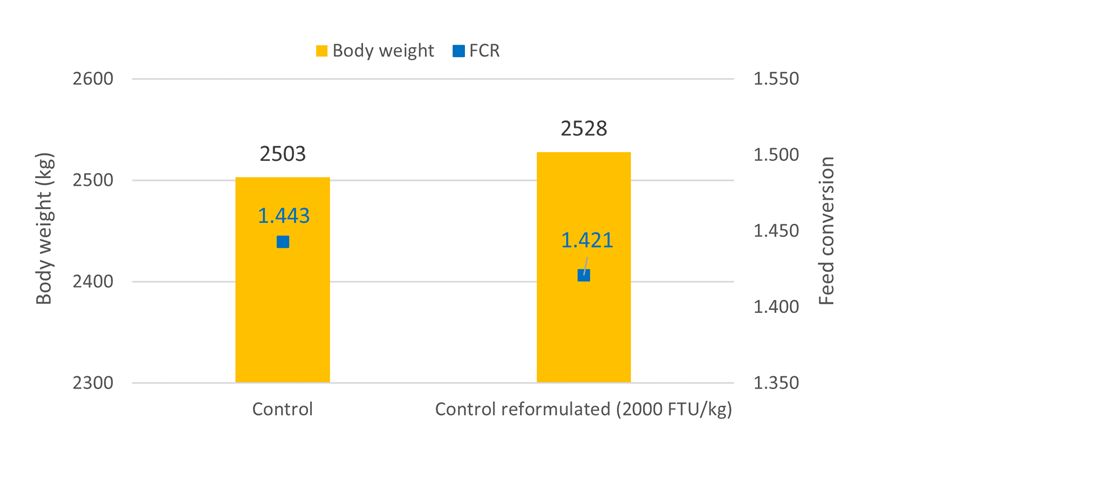In the last two years, increasing prices of inorganic phosphorus (P) sources has led to higher inclusion levels of phytase in poultry diets. While previously the inclusion of phytase was usually fixed at 500 and 1000 FTU/kg of feed, levels have since increased to 1500 and 2000 FTU/kg. These higher levels of phytase reduce the cost of the feed by replacing inorganic P. Although the recent drop in prices of inorganic P sources has tempered this tendency, it is still economically viable to consider higher dosing (often termed superdosing) of phytase as it optimises animal performance.
The antinutritional effects of phytate
Phytate-phosphorus, the storage form of P in plants, is composed of a myo-inositol ring with six phosphate groups attached. As this molecule carries a very negative charge, it will bind in the gastrointestinal tract with any nutrient that has a positive charge (Figure 1). This binding can be to macro minerals like calcium (Ca), microminerals such as zinc and copper, but also amino acids. When these nutrients are bound to the phytate molecule, they are unavailable for absorption by the animal.

In addition, phytate is known to increase the loss of endogenous protein. This lost protein will be replaced by protein from the feed which is then not available to the animal to enhance performance.
By superdosing phytase, more phytate is broken down which reduces the binding of valuable nutrients, ensuring they stay available to the animal, enhancing its performance.
In large broiler studies it is shown that increasing the inclusion levels of the heat stable phytase OptiPhos® Plus improves protein digestibility as well as P digestibility. The general trend is that with increasing concentrations of phytase, protein digestibility also increases (Table 1).

Realistic expectations
Looking at the claimed improvements in protein digestibility as reflected in proposed matrix values for some phytases currently on the market, it shows that claims of up to 4-5% improvements due to superdosing are being made. In most cases, the supporting studies were carried out with feed formulations not at all similar to the commercial specifications of feeds. These feeds would not be commercially viable and would deliver very poor technical results. In other trials, excess protein is provided in the feed, making it easy to prove the claimed amino acid matrix values for a phytase - you are simply removing the excess protein which is not contributing to performance anyway.
The golden rule regarding expectations of the improved protein digestibility by superdosing phytase in commercial feeds which are adequate and well balanced in digestible amino acids, can be stated as such:
- 1% improvement: sure
- 2% improvement: maybe
- 3% improvement: do not count on it!
Similarly, the enhancement of performance in trials sometimes shows very positive results, but in many of these trials this can be linked to below standard feed formulations (e.g., excess Ca combined with borderline P in the control feed which is not supplemented with phytase). However, a more moderate expectation (and reference) was recently observed in a very large research study in Indonesia. In this trial, a high-quality corn/soy feed was reformulated with the Ca and P matrix values of OptiPhos Plus at 2000 FTU/kg. The performance of the birds reached the intended objectives of performance (according to the guidelines), while the addition of 2000 FTU/kg of OptiPhos Plus delivered extra growth of 25 g and a feed conversion reduction of approximately 0.02. This yielded an extra financial benefit of 5 euro cents per broiler (Figure 2).

The economics of superdosing: it pays for itself and more
An estimate of how much performance needs to increase to be economically beneficial when shifting from a dose of 500 FTU/kg to 1000 or 2000 FTU/kg is shown in Table 2. To simplify things, it is assumed that there is no feed price reduction due to reformulation at 1000 or 2000 FTU/kg (which is generally not the case). To be economically viable means that the inclusion of the higher level of phytase needs to be paid by performance improvements.
Assuming broiler weight at 35 days and a feed conversion of 1.5, only a 2.5 to 7.5 g higher end weight, or a 0.003 to 0.008 improvement in feed conversion (or any combination) at 1000 and 2000 FTU/kg is needed to reach financial break even. The improvement is much higher than this (as seen above in Figure 2), thus the phytase pays for itself and more.




